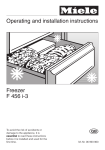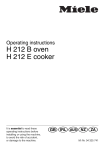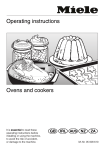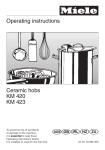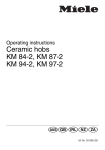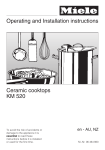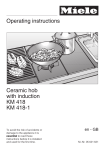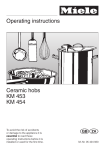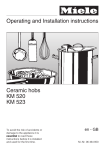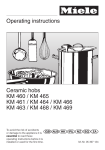Download Miele KM 440 Operating instructions
Transcript
Operating instructions Ceramic hobs It is essential to read these operating instructions before installing or using the machine, to avoid the risk of accident, or damage to the machine. @Q\ä} M.-Nr. 04 847 900 Description of the appliance Description of the appliance KM 440 KM 441 1 2 3 4 5 - + - + - + - + - + - + - + - + 7 8 9 10 11 12 2 Description of the appliance KM 443 KM 440 KM 441 b Cooking zone: 14.5 cm Ø c Cooking zone: 21 cm Ø d Cooking zone: 14.5 cm Ø e Cooking zone: 18 cm Ø b Vario cooking zone: 12 cm / 21 cm Ø c Cooking zone: 14.5 cm Ø d Cooking zone: 18 cm Ø e Cooking zone: 14.5 cm Ø KM 443 b Vario cooking zone: 12 cm / 21 cm Ø c Cooking zone: 14.5 cm Ø d Cooking zone / Extended zone: 17 cm Ø / 17 cm x 26.5 cm e Cooking zone: 18 cm Ø Sensor touchpads f Vario-cooking zone g Extended zone h Rear left cooking zone control and display i Rear right cooking zone control and display j Front right cooking zone control and display k Front left cooking zone control and display l Locking m Operation On-Off control, Safety switch-off function 3 Contents Contents Description of the appliance . . . . . . . . . . . . . . . . . . . . . . . . . . . . . . . . . . . . . . . . . 2 Contents . . . . . . . . . . . . . . . . . . . . . . . . . . . . . . . . . . . . . . . . . . . . . . . . . . . . . . . . . 4 Caring for the environment . . . . . . . . . . . . . . . . . . . . . . . . . . . . . . . . . . . . . . . . . . 5 Warning and Safety instructions . . . . . . . . . . . . . . . . . . . . . . . . . . . . . . . . . . . . . 6 Use. . . . . . . . . . . . . . . . . . . . . . . . . . . . . . . . . . . . . . . . . . . . . . . . . . . . . . . . . . . . . Sensor touchpads . . . . . . . . . . . . . . . . . . . . . . . . . . . . . . . . . . . . . . . . . . . . . . . . . Using the hob. . . . . . . . . . . . . . . . . . . . . . . . . . . . . . . . . . . . . . . . . . . . . . . . . . . . . Residual heat indicators. . . . . . . . . . . . . . . . . . . . . . . . . . . . . . . . . . . . . . . . . . . . . Locking function. . . . . . . . . . . . . . . . . . . . . . . . . . . . . . . . . . . . . . . . . . . . . . . . . . . Safety switch-off functions . . . . . . . . . . . . . . . . . . . . . . . . . . . . . . . . . . . . . . . . . . . Avoiding activating the touchpads by mistake . . . . . . . . . . . . . . . . . . . . . . . . . . . Auto heat up. . . . . . . . . . . . . . . . . . . . . . . . . . . . . . . . . . . . . . . . . . . . . . . . . . . . . . Extended cooking zones (not with KM 440) . . . . . . . . . . . . . . . . . . . . . . . . . . . . . Saucepans . . . . . . . . . . . . . . . . . . . . . . . . . . . . . . . . . . . . . . . . . . . . . . . . . . . . . . . Please observe the following good practice guide:. . . . . . . . . . . . . . . . . . . . . . . . 10 10 10 11 12 12 12 13 14 15 16 Cleaning and care . . . . . . . . . . . . . . . . . . . . . . . . . . . . . . . . . . . . . . . . . . . . . . . . 17 Problem solving guide. . . . . . . . . . . . . . . . . . . . . . . . . . . . . . . . . . . . . . . . . . . . . 19 After sales service . . . . . . . . . . . . . . . . . . . . . . . . . . . . . . . . . . . . . . . . . . . . . . . . 20 Installation instructions. . . . . . . . . . . . . . . . . . . . . . . . . . . . . . . . . . . . . . . . . . . . Notes on installation . . . . . . . . . . . . . . . . . . . . . . . . . . . . . . . . . . . . . . . . . . . . . . . . Worktop cut-out . . . . . . . . . . . . . . . . . . . . . . . . . . . . . . . . . . . . . . . . . . . . . . . . . . . Worktop cut-out AUS/NZ . . . . . . . . . . . . . . . . . . . . . . . . . . . . . . . . . . . . . . . . . . . . Fitting . . . . . . . . . . . . . . . . . . . . . . . . . . . . . . . . . . . . . . . . . . . . . . . . . . . . . . . . . . . 21 21 22 23 24 Electrical connection . . . . . . . . . . . . . . . . . . . . . . . . . . . . . . . . . . . . . . . . . . . . . . 25 Caring for the environment Caring for the environment Disposal of the packing material Disposal of your old machine / appliance The transport and protective packing has been selected from materials which are environmentally friendly for disposal and can normally be recycled. Old machines / appliances contain materials which can be reclaimed or recycled. Please contact your dealer, your local waste collection centre or scrap merchant about potential recycling schemes. Rather than just throwing these materials away, please ensure that they are offered for recycling. Ensure that the machine / appliance presents no danger to children while being stored for disposal. See the appropriate section in the Warning and Safety instructions. Data plate When the appliance has been built in the data plate is no longer visible. A further data plate label is supplied with the appliance. For easy reference stick the label into this booklet under "After sales service". 5 Warning and Safety instructions Warning and Safety instructions This appliance complies with all relevant legal safety requirements. Improper use of the appliance can, however, present a risk of both personal injury and material damage. Before installation and before using the appliance for the first time, read the operating instructions carefully. They contain important notes on safety, on the operation and care of the appliance. This way you will avoid the risk of accidents and damage to the appliance. Do not let children access the appliance or its controls. Supervise its use by the elderly or infirm. Keep these instructions in a safe place and pass them on to any future user. Correct usage The appliance is intended for domestic use to cook food, and in particular to heat up, boil, simmer or fry. Any other usage is at the owner’s risk and could be dangerous. The manufacturer cannot be held responsible for damage caused by improper use of the appliance. 6 Technical safety Before connecting the appliance to the mains supply make sure that the connection data given on the data plate correspond to those of the mains supply. It is essential that these data match, to avoid any damage to the appliance. Consult a competent person if in doubt. The electrical safety of this appliance can only be guaranteed when continuity is complete between the appliance and an effective earthing system, which complies with local and national regulations. It is most important that this basic safety requirement is tested by a qualified electrician. The manufacturer cannot be held responsible for the consequences of an inadequate earthing system. This appliance must only be operated as a built-in appliance. This is necessary to ensure that all electrical components are shielded. Never open the casing of the appliance. Tampering with electrical connections or components and mechanical parts is highly dangerous to the user and can cause operational faults. Warning and Safety instructions Warning and Safety instructions Installation work and repairs may only be carried out by suitably qualified and competent persons to ensure safety. Repairs and other work by unqualified persons could be dangerous. The appliance is only completely isolated from the electricity supply when: – it is switched off at the wall socket, or isolator, – or the mains fuse is withdrawn, – or the screw-out fuse is removed (in countries where this is applicable). Do not connect the appliance to the mains electricity supply by an extension lead. Extension leads do not guarantee the required safety of the appliance. The hob may not be built in over a dishwasher or fridge, fridgefreezer or freezer. The high radiant temperatures which are sometimes generated by the hob could damage such appliances. If the hob is built in above an oven, the connecting cable of the hob must be positioned in such a way that it cannot come into contact with the oven housing. Use Caution, danger of burning. High temperatures are produced by the hob cooking zones Do not let small children touch the appliance during operation. Not only do the cooking zones of the hob heat up, but also the control panel. Danger of burning. Keep all pans out of the reach of children. Supervise use of the hob by the elderly and infirm. When switched on the cooking zones heat up. The residual heat indicators will show whether a cooking zone is switched on, or is still hot. Do not leave the appliance unattended when cooking with oils and fats as these are fire hazards if overheated. Do not use the hob to heat up the room. The high temperatures of the hob could cause inflammable objects in the vicinity to catch fire. In the event of any breakages or cracks occuring in the ceramic hob it must be switched off immediately and disconnected from the electricity supply. Contact the Miele Service Department. Continued use would be dangerous as liquids etc boiling over could penetrate the electrical components through the crack(s). 7 Warning and Safety instructions Warning and Safety instructions Do not use the hob as a resting place for anything else. This could lead to a danger of the article beginning to melt or catching fire, if the hob were to be switched on inadvertently. Take care to keep the touchpads and the area around them clean and do not put things down on them. Hot pans can damage the electronics which are under the sensors. When cleaning the hob surface do not push the dirt across the touchpads. The sensors could mistake the article or dirt for a finger tip contact, thereby activating a function. Do not drop anything on the ceramic hob. Dropping a salt cellar, for example, could be the cause of damage in certain circumstances. Do not use plastic or aluminium foil containers. These melt at higher temperatures and could damage the ceramic surface. Do not allow either solid or liquid sugar or pieces of plastic or aluminium foil to get onto the ceramic hob when it is hot. If this is allowed to cool before the hob has been cleaned, the ceramic surface will be susceptible to pitting or even cracking. Switch the cooking zones off and while the hob is still warm, scrape all the sugar, plastic or aluminum remains from the hob with a shielded scraper blade taking care not to burn yourself. 8 Do not use any pots or pans on the ceramic hob with bases with pronounced edges or ridges. These could scratch or scour the hob surface permanently. If a drawer is fitted directly underneath the hob without any wooden base in between, ensure that no aerosols, combustible liquids or other easily flammable materials are kept in it. If cutlery inserts are to be placed in the drawer, these must be made of suitable heat-resistant material. When using kitchen appliances connected to sockets near the ceramic hob ensure that the cable cannot touch a heated hob zone or pan. The insulation on the cable could become damaged, giving rise to an electric shock hazard. Always ensure that food is sufficiently cooked or reheated. Many factors will affect the overall cooking time, including the size and amount of food, its temperature, changes to the recipe and the shape and size of cooking container. Some foods may contain micro organisims which are only destroyed by thorough cooking, therefore when cooking or reheating foods, e.g. poultry, it is particularly important that food is fully cooked through (at more than 70 °C, for more than 10 minutes). If in doubt select a longer cooking or reheating time. Warning and Safety instructions Warning and Safety instructions It is essential to ensure that food has been evenly and sufficiently heated, and to check that it is thoroughly cooked, turning or stirring during cooking if necessary. Under no circumstances use a "steam cleaner" to clean this appliance. Pressurised steam could cause permanent damage to the surface and to components, for which the manufacturer cannot accept responsibility. There is a seal between the hob frame and worktop and between the frame and the ceramic plate. Do not use any sharp pointed object, such as a knife, to clean these seals as they could become damaged. Disposal of a discarded appliance Before discarding an old appliance / machine switch off and disconnect it from the power supply. Cut off and render any plug useless. Cut off the cable directly behind the appliance / machine to prevent misuse. The manufacturer cannot be held liable for damage caused by noncompliance with safety instructions. In countries which may be subject to infestation by cockroaches or other vermin, pay particular attention to keeping the appliance and its surroundings in a clean condition at all times. Any damage which might be caused by cockroaches or other vermin will not be covered by the appliance guarantee. Accessories After using the shielded razor blade scraper always ensure the blade is guarded to avoid the danger of injury. 9 Use Use Sensor touchpads This hob is equipped with electronic sensor controls. Finger tip pressure on a touchpad will activate its functions. Only press the relevant touchpad. If two or more touchpads are touched at the same time the entries will be ignored. Nothing will happen. Take care to keep the touchpads and the area around them clean and do not put things down on them. Hot pans can damage the electronics under the sensors. When cleaning the hob surface do not push the dirt across the touchpads. The sensors could mistake the article or the dirt for a finger tip contact, thereby activating a function. Switching on the hob Hold your finger on the Operation onoff control "s" for approx 2 seconds. In each of the four zone displays "–" appears. Now the individual cooking zones can be switched on. If no zone is selected within a certain period the hob switches itself off and has to be switched on again. Switching on a cooking zone Touch the "s" control for the zone selected. "0" appears in the display for the selected zone. The cooking zone is switched on but will not heat up until a setting has been chosen. Choosing a setting Using the hob When the hob is not in use all touchpad displays are switched off. Before using for the first time On first use the hob may give off a slight smell as moisture in the insulation evaporates. Before using the ceramic hob, first clean the surface thoroughly (see the section on "Cleaning and care"). 9 settings are available (see the chart for selection). The _ controls of the relevant zone are used to select a setting. Press the _ controls of the relevant zone until the required setting appears in the display. Press the > control to increase the setting step by step (0, 1, 2, ... 9), press the $ control to select lower settings (9, 8, 7, ... 0). Changing a setting Press the _ control of the relevant zone until the required setting appears in the display. 10 Use Use Suggested hob settings Switching off a cooking zone Setting Melting butter, Chocolate Dissolving gelatine Preparing junket and yoghurt Keeping food warm Warming small quantities of food/liquid Thickening sauces containing egg yolk, butter Omelettes Defrosting Cooking rice, pasta, porridge, Steaming fruit, vegetables, fish, Cooking broths, pulse soups Braising meat, fish, vegetables Cooking dumplings, potatoes, soups Preparing jams, jellies, stewed fruit Frying fish, Frying cutlets Frying pancakes, Frying liver, sausages, fried eggs Searing large quantities of meat Frying steaks, potato or fish cakes Boiling large quantities of food 1 1–2 2–3 3–5 5–6 6–7 Press the "s" control of the required cooking zone. While the zone is still hot "H" flashes in the display (see residual heat indicators). When "-" appears in the display the zone is cool to the touch. If no other cooking zones are switched on, the hob switches itself off after a short time. Residual heat indicators After any zone has been switched off "H" flashes in the display while it is still hot. Do not touch these cooking zones or place any heat sensitive object on them. Danger of burning. N.B. If there is an interruption to the power supply, the "H" will disappear even if the cooking zone is still hot. 7–9 9 These figures, which envisage approx. 4 helpings, should only be taken as a guide. With deep pans, large quantities, or without the lid on, a higher setting is needed. With smaller quantities select a lower setting. 11 Use Use Locking function The hob zones can be locked to prevent inadvertent use when the hob is in operation. Processes currently in operation will continue and the settings displayed will remain active. We recommend locking the touchpads to avoid children, pets etc tampering with the appliance. Press the locking touchpad "a" until the dot above it lights up. Cancelling the lock Press touchpad "a", until the dot above it goes out. Safety switch-off functions If a cooking zone has been in use for an exceptionally long time, the safety switch-off is automatically activated. The length of time, between one and ten hours, depends on which power setting was chosen. The higher the power setting the shorter the period until switch-off. In addition each cooking zone is fitted with an internal temperature limiter which switches off the cooking zones if the ceramic surface is overheated. It is possible to switch off all cooking zones simultaneously, even if they are locked. Press the Operation on-off control "s" until the hob is switched off. 12 Avoiding activating the touchpads by mistake Do not put any kitchen accessories such as lids, cutlery or cloths down on the touchpads. Always keep the sensor touchpad controls and the area around them clean and do not put things down on them. Hot pans could damage the electronics under the sensors. Remove dirt and spills immediately. The sensors could mistake the article or dirt for a finger tip contact, thereby activating switching operations. Use Use Auto heat up Each cooking zone is fitted with an auto heat up feature which can be selected when required. When auto heat up is being used the cooking zone operates at a high power level. After the auto heat up period the zone is automatically switched to the continued cooking level selected and the heat setting is reduced accordingly (without needing to be adjusted manually). When auto heat up is switched on a dot is visible behind the setting. Heat up times The length of the auto heat up period depends on the setting selected. Various optimum heat up times are allocated to both the settings for cooking (Settings 2 – 5) and also to the settings for frying (Settings 6 – 9) . Type of settings Setting Heat up time - mins (approx) Warming up, Keeping warm 1 1.5 Cooking 2 3 4 5 2.5 4 5,5 7 Frying 6 7 8 9 1.5 2.5 2.5 –* With the settings for cooking, the higher the setting, the longer the heat up time. With the settings for frying the times are shorter, as it is more usual to pre-heat an empty pan before frying. Switching on auto heat up Switch the hob on by pressing the Operation on-off control "s" for approx 2 seconds. "-" appears in the display. Switch on the cooking zone required by pressing the "s" control for that zone. "0" appears in the display. Select setting 9 by pressing once on the $ control for that zone. "9" appears in the display. Touch the > control for that zone once. "9 " appears in the display. X You now have a few seconds to select the setting for continued cooking after which the dot goes out and auto heat up would have to be switched on again. Select the setting for continued cooking by pressing the $ control until the required setting appears in the display. The dot is still there next to the setting number, and this will only go out when the auto heat up period has finished and the continuation period has started. * This setting is always heated on maximum power. 13 Use Extended cooking zones (not with KM 440) The cooking zones are marked on the hob. Some cooking zones can be enlarged. These are the extended cooking zone rear right (with KM 443) and the vario cooking zone front left. The cooking zone itself must be switched on before the extended option can be selected. 14 Vario-zone n (only with KM 441 and KM 443) Press the vario-zone touchpad "n", if you want to switch on the larger zone. A dot lights up above the touchpad. Extended cooking zone x (only with KM 443) Press the touchpad for the extended cooking zone "x", if you want to switch it on. A dot lights up above the touchpad. Use Use Saucepans Pan size The following notes are designed to enable you to – make the best use of energy when using your ceramic hob. – prevent food boiling over and burning onto the hob. Suitable pans The diameter of the pan should be a little larger than that of the cooking zone. Pan lids So that optimum energy consumption is achieved during cooking, only pans with flat or very slightly concave bases should be used. When the pan is hot, the base should rest evenly on the ceramic surface. Check for suitability when purchasing new pans. A lid on the pan will prevent heat from being lost. 15 Use Use Please observe the following good practice guide: Always place a pan centrally on the cooking zone before switching on the appliance to save energy. The cooking zone and the pan base should be clean and dry. This saves unnecessary cleaning after cooking. Always check before beginning to cook that there are no sand-like grains on the ceramic surface. If such grains should find their way underneath the saucepan when it is pushed across the hob the grains could cause scratches on the surface. Do not use any pots or pans which have bases with pronounced edges or ridges or are enamelled unevenly. These could scratch or scour the hob surface. Do not push any enamelled objects such as baking trays or roasting pans around on the hob. This could cause scratches. 16 When using aluminium utensils the metal can affect the ceramic surface by leaving mother-of-pearl coloured marks behind. These marks can be removed most easily if they are treated immediately they appear with a special proprietary cleaning agent (see chapter on "Cleaning and Care"). Do not allow either solid or liquid sugar or pieces of plastic or aluminium foil to lie on the heated cooking zones. If spills are left on the ceramic surface until it has cooled down, these will cause variable pitting, and could even cause cracking. When spills occur, therefore, switch the cooking zone off and immediately scrape off all the residues with a shielded razor blade scraper. Take care not to burn yourself. Cleaning and care Cleaning and care In general you can use the same cleaning agents for the ceramic hob surface as you would for ordinary glass surfaces. Never use scouring agents or pads, or strong cleaners such as oven sprays or stain or rust removers, as these could harm the surface. There is a seal between the hob frame and worktop and between the frame and the ceramic plate. Do not use any sharp pointed object, such as a knife, to clean these seals as they could become damaged. Clean after each use Take care to keep the touch pads and the area around them clean and do not put things down on them. Hot pans can damage the electronics under the sensors. When cleaning the hob surface do not push the dirt across the touch pads. The sensors could mistake the article or dirt for a finger tip contact, thereby activating a function. Any minor spills which have not dried on can be wiped off with a damp cloth or sponge. Non-abrasive liquid cleaners can also be used. If the hob is cleaned with washing up liquid for example, light blue staining might occur. These stains can be removed with one of the proprietary agents mentioned, although they can be stubborn, and it may take several applications. Hardened spills should be carefully scraped off using a shielded razor blade scraper. The hob surface should then be rubbed clean with a damp cloth or sponge. To remove marks Light marks with a metallic sheen (aluminium deposits) on the hob surface can be removed once the hob has cooled down by using a suitable proprietary cleaner. Lime deposits (caused for example by water boiling over) can be removed with vinegar or a proprietary hob cleaner. 17 Cleaning and care Cleaning and care Removal of sugar, syrups, plastic or aluminium foil. Switch the hob off and scrape off all the residues straight away with a shielded razor blade scraper while it is still hot. Protect your hands from the heat. Once the cooking zone has cooled down clean with a suitable cleaner. Cleaning agents for regular cleaning There are several proprietary cleaners suitable for vitreous ceramic surfaces. Follow the manufacturer’s cleaning and care instructions. Do not use the cleaner while the cooking zone is hot. Ensure that any residues of cleaning agent are removed from the hob surface with a damp cloth. Otherwise these could have an etching effect when the zone is heated up. Some cleaners incorporate a silicone agent which acts as a protective film on the ceramic hob. However, cooking at high temperatures reduces the effect and the cleaner needs to be reapplied for renewed effect. 18 Problem solving guide Problem solving guide Repairs to the electrical components of this appliance should only ever be carried out by a competent person. Unauthorised repairs can be dangerous. Some minor problems however can be dealt with as follows: What to do if . . . . . . there is a slight smell when the hob is heated for the very first time. This is not a fault. Residual moisture in the insulation is drying out. . . . it is not possible to switch on the cooking zones. Check if the zone lock is on. If all the indicator lights are switched off check whether the house mains fuse has blown. Call an electrician or the Service Department. . . . a cooking zone switches off during use and "H" repeatedly flashes in the display. This is not a fault. If a cooking zone has been switched on for an exceptional length of time the safety switch or feature is activated. This can be after a period of 1 to 10 hours depending on the setting originally selected. The higher the setting the shorter the time to auto switch off. To switch on the cooking zone again. Select setting "0" and then once again the setting required. If "H" flashes in one or more displays this is not a fault but a signal that these zones are still hot. . . . when using auto heat up the content of the pan does not cook satisfactorily check whether a pan with a heat retaining base is being used. The warmth from this base only transfers slowly into the food. Whether a rather large pan is being used. In both cases select a higher setting for continued cooking, or bring to the boil with setting "9" and then switch to a lower setting. 19 After sales service After sales service In the event of any fault which you cannot remedy yourself, please contact – your Dealer When contacting the Service department please quote the model and serial number of your appliance which are shown on the data plate. or – the nearest authorised Customer Service department (address on back page). Space for data plate label 20 Installation instructions Installation instructions Notes on installation Ceramic hob The model, voltage and rated load are given on the hob data plate. These must match the mains supply. When contacting the Service Department please quote voltage, model and serial numbers given on the data plate. These hobs are classified as "Y" class for heat protection (IEC regulation 335-2-6) (not Australia). Fit wall units and adjacent tall units before fitting the ceramic hob, to avoid the danger of damaging the hob. Ideally the hobs should be installed with plenty of space on either side. There may be a wall at the rear and wall or tall units at one side. On the other side however no unit or divider must stand higher than the hob. The veneer or laminate coatings of worktops (or adjacent kitchen units) must be treated with 100 °C heat resistant adhesive which will not dissolve or distort. The hob may not be built in over a dishwasher or fridge, fridge-freezer or freezer. The high radiant temperatures which are sometimes generated by the hob could damage such appliances. If the hob is built in above an oven, the connecting cable of the hob must be positioned in such a way that it cannot come into contact with the oven housing. Due to the heat radiated from the hob unit, it is essential that the following minimal distances are maintained.: – 40 mm between the worktop cutout and adjacent kitchen units (e. g. Tall unit) – 50 mm between the worktop cutout and the rear wall 21 Installation instructions Installation instructions Worktop cut-out Cut the worktop according to the dimensions in the relevant diagram, keeping within the tolerances given. Ensure that there is a depth of at least 64 mm at the rear right for the connecting cable. Ensure that there are minumum distances of 50 mm between the rear wall and the hob and 40 mm between a right or left side wall and the hob. Seal the cut surfaces with a suitable sealant to avoid swelling caused by moisture. The materials used must be heat-resistant. 22 Installation instructions Worktop cut-out AUS/NZ Cut the worktop according to the dimensions in the relevant diagram, keeping within the tolerances given. Ensure that there is a depth of at least 64 mm at the rear right for the connecting cable. Ensure that there are minumum distances of 50 mm between the rear wall and the hob and 40 mm between a right or left side wall and the hob. Seal the cut surfaces with a suitable sealant to avoid swelling caused by moisture. The materials used must be heat-resistant. 23 Installation instructions Fitting Granite worktops Place the special clamps b in position and then secure with strong double sided tape. In addition, coat with silicone sealant. The screws are not necessary for granite worktops. Guide the hob cable down through the cut-out and connect the hob to the power supply. Position the hob. Then with a hand on each side of the hob press down on the edges evenly until it clicks into place. When doing this take care that the edge of the hob is lying flat above the worktop on all sides. (The hob can now only be removed with a special tool). Shelf fitted underneath If there is a shelf underneath the hob there must be a minimum distance of 55 mm between the hob and the shelf. There must be an additional air gap of 10 mm between the rear wall and the back of any shelf. Fix the special spring clamps b supplied at the marked positions by laying them on the upper edge of the cut-out and then securing them with the 3.5 x 25mm screws supplied. 24 Electrical connection Electrical connection General notes All electrical work should be carried out by a suitably qualified and competent person, in strict accordance with national and local safety regulations. The voltage and rated load are given on the data plate. Please ensure that these match the household mains supply. Electrical connection AUS (NZ) The appliance is supplied with a mains cable for connection to an a.c. single phase or a 2-phase 240 V (230 V), 50 Hz supply. Connection should be made via a suitable isolator which complies with national and local safety regulations, and which is accessible after the appliance has been built in. After the appliance has been built in, a check must be made that all electrical parts are shielded. No live parts must be exposed to the touch. Test marks When switched off there must be an allpole gap of at least 3 mm in the isolator switch. For extra safety it is advisable to install a residual current device (RCD), with a trip current of 30 mA. Important Electrical connection U.K. The appliance is supplied with a mains cable for connection to an a.c. single phase 240 V (230 V), 50 Hz supply. Connection should be made via a suitable isolator which complies with national and local safety regulations, and which is accessible after the appliance has been built in. Important The wires in the mains lead are coloured in accordance with the following code: Green/yellow = earth Blue = neutral Brown = live Electrical safety, C-Tick Mark Electrically suppressed according to AS/NZS 1044 The wires in the mains lead are coloured in accordance with the following code: Green/yellow = earth Blue = neutral Brown = live Black = live. In case of a single phase supply bridge brown and black wires. WARNING THIS APPLIANCE MUST BE EARTHED In other countries, check with your supplier. 25 26 27 Alterations rights reserved / 006 AUS / GB / IRL / NZ / ZA – 3500 M.-Nr. 04 847 900 (KM 440, KM 441, KM 443) This paper consists of cellulose which has been bleached without the use of chlorine.




























